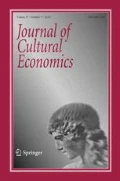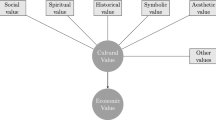Abstract
Contingent valuation methods (CVM) are now well established as a means of measuring the nonmarket demand for cultural goods and services. When combined with valuations provided through market processes (where relevant), an overall assessment of the economic value of cultural commodities can be obtained. Within a neoclassical framework, such assessments are thought to provide a complete picture of the value of cultural goods. But are there aspects of the value of cultural goods which are not fully captured, or not captured at all, within such a model? This paper argues that CVM provides an incomplete view of the nonmarket value of cultural goods, and that alternative measures need to be developed to provide a fuller account.
Similar content being viewed by others
References
Avrami, Erica, Mason, Randall, and De La Torre, Marta (eds.) (2000) Values and Heritage Conservation. Getty Conservation Institute, Los Angeles.
Bateman, Ian J. and Willis, Kenneth G. (eds.) (1999) Valuing Environmental Preferences: Theory and Practice of the Contingent Valuation Method in the U.S., EU and Developing Countries. Oxford University Press, Oxford.
Baumol, William J. and Bowen, William G. (1966) Performing Arts: The Economic Dilemma. Twentieth Century Fund, New York.
Benedikt, Michael (1997) “Value and Psychological Economics: An Outline”, in Michael Benedikt et al. (eds.), Value: Center 10/Architecture and Design in America. University of Texas Press, Austin.
Bille Hansen, Trine (1997) “TheWillingness-to-Pay for the Royal Theatre in Copenhagen as a Public Good”. Journal of Cultural Economics 21: 1–28.
Bille Hansen, Trine, Christoffersen, Henrik, and Wanhill, Stephen (1998) “The Economic Evaluation of Cultural and Heritage Projects: Conflicting Methodologies”. Tourism, Culture and Communication 1: 27–48.
Clark, Charles M.A. (1995),“From Natural Value to Social Value”, in Charles M.A. Clark (ed.), Institutional Economics and the Theory of Social Value: Essays in Honour of Marc R. Tool. Kluwer, Boston.
Connor, Steven (1992) Theory and Cultural Value. Blackwell, Oxford.
Cuccia, Tiziana and Signorello, Giovanni (2000) “A Contingent Valuation Study of Willingness to Pay for Visiting a City of Art: The Case Study of Noto (Italy)”. Paper presented at Conference of the Association for Cultural Economics International, Minneapolis, 28–31 May.
De La Torre, Marta (ed.) (2002) Assessing the Values of Cultural Heritage. Getty Conservation Institute, Los Angeles.
Di Maggio, Paul (2003) “Book Review of Throsby (2001)”. Journal of Cultural Economics 27: 73–75.
Etlin, Richard A. (1996) In Defense of Humanism: Value in the Arts and Letters. Cambridge University Press, New York.
Gérard-Varet, Louis-André, Kolm, Serge-Christophe, and Mercier-Ythier, Jean (eds.) (2000) The Economics of Reciprocity, Giving and Altruism. St. Martin's Press, New York.
Hammond, Peter J. (1987) “Altruism”, in John Eatwell et al. (eds.), The New Palgrave: A Dictionary of Economics. Macmillan, London, pp. 85–87.
Hausman, Jerry A. (ed.) (1993) Contingent Valuation: A Critical Assessment. North-Holland, Amsterdam.
Head, John G. (1990) “On Merit Wants: Reflections on the Evolution, Normative Status and Policy Relevance of a Controversial Public Finance Concept”, in Geoffrey Brennan and Cliff Walsh (eds.), Rationality, Individualism and Public Policy. Centre for Research on Federal Financial Relations, Australian National University, Canberra.
Klamer, Arjo (2002) “Social, Cultural and Economic Values of Cultural Goods”. Paper presented at Conference of the Association for Cultural Economics International, Rotterdam, 13–15 June.
Kling, Robert, Revier, Charles, and Sable, Karin (2000) “Estimating the Public-Good Value of Preserving a Local Historic Landmark: The Role of Non-Substitutability and Information in Contingent Valuation”. Paper presented at Conference of the Association for Cultural Economics International, Minneapolis, 28–31 May.
Koerner, Joseph Leo and Koerner, Lisbet (1996) “Value”, in Robert S. Nelson and Richard Shiff (eds.), Critical Terms for Art History. University of Chicago Press, Chicago.
Martin, Fernand (1994) “Determining the Size of Museum Subsidies”. Journal of Cultural Economics 18: 255–270.
McCain, Roger A. (1981) “Cultivation of Taste, Catastrophe Theory and the Demand for Works of Art”. American Economic Review 71: 332–334. Reprinted in Ruth Towse (ed.) (1997) Cultural Economics: The Arts, the Heritage and the Media Industries, Vol. I. Edward Elgar, Cheltenham, pp. 148–150.
Mirowski, Philip (1990) “Learning the Meaning of a Dollar: Conservation Principles and the Social Theory of Value in Economic Theory”. Social Research 57: 689–717.
Mitchell, Robert C. and Carson, Richard T. (1989) Using Surveys to Value Public Goods: The Contingent Valuation Method. Johns Hopkins University Press, Baltimore.
Morrison, William G. and West, Edwin G. (1986) “Subsidies for the Performing Arts: Evidence on Voter Preference”. Journal of Behavioral Economics 15: 57–72. Reprinted in Ruth Towse (ed.) (1997) Cultural Economics: The Arts, the Heritage and the Media Industries, Vol. II. Edward Elgar, Cheltenham, pp. 647–662.
Mourato, Susana, Kontoleon, Andreas and Danchev, Alexi (2002) “Preserving Cultural Heritage in Transition Economies: A Contingent Valuation Study of Bulgarian Monasteries”, in Ståle Navrud and Richard C. Ready (eds.), Valuing Cultural Heritage: Applying Environmental Valuation Techniques to Historic Buildings, Monuments and Artefacts. Edward Elgar, Cheltenham, pp. 68–86.
Navrud, Ståle and Ready, Richard C. (2002) Valuing Cultural Heritage: Applying Environmental Valuation Techniques to Historic Buildings, Monuments and Artefacts. Edward Elgar, Cheltenham.
Noonan, Doug (2003) “Contingent Valuation of Cultural Resources: A Meta-Analytic Review of the Literature”. Journal of Cultural Economics 27: 159–176.
Nijkamp, Peter (1995) “Quantity and Quality: Evaluation Indicators for our Cultural-Architectural Heritage”, in Harry Coccossis and Peter Nijkamp (eds.), Planning for Our Cultural Heritage. Avebury, Aldershot.
Pagiola, Stefano (1996) “Economic Analysis of Investment in Cultural Heritage: Insights from Environmental Economics”. World Bank, Washington mimeo.
Papandrea, Franco (1999) “Willingness to Pay for Domestic Television Programming”. Journal of Cultural Economics 23: 149–166.
Peacock, Alan (1969) “Welfare Economics and Public Subsidies to the Arts”. TheManchester School of Economic and Social Studies 37: 323–335. Reprinted in Ruth Towse (ed.) (1997) Cultural Economics: The Arts, the Heritage and the Media Industries, Vol. II. Edward Elgar, Cheltenham, pp. 501–513.
Pollicino, Marilena and Maddison, David (2001) “Valuing the Benefits of Cleaning Lincoln Cathedral”. Journal of Cultural Economics 25: 131–148.
Santagata, Walter and Signorello, Giovanni (2000) “Contingent Valuation of a Cultural Public Good and Policy Design: The Case of ‘Napoli Musei Aperti’'. Journal of Cultural Economics 24: 181–204.
Throsby, David (2000) “Economic and Cultural Value in the Work of Creative Artists”, in Erica Avrami, Randall Mason and Marta De La Torre (eds.), Values and Heritage Conservation. Getty Conservation Institute, Los Angeles, pp. 26–31.
Throsby, David (2001) Economics and Culture. Cambridge University Press, Cambridge.
Throsby, David and Withers, Glenn (1979) The Economics of the Performing Arts. Edward Arnold, London.
Throsby, David and Withers, Glenn (1983) “Measuring the Demand for the Arts as a Public Good: Theory and Empirical Results”, inW.S. Hendon and J.L. Shanahan (eds.), Economics of Cultural Decisions. Abt Books, Cambridge, Mass.
Throsby, David and Withers, Glenn (1984) What Price Culture? Australia Council, Sydney. Reprinted in Ruth Towse (ed.) (1997) Cultural Economics, The Arts, the Heritage and the Media Industries, Vol. II. Edward Elgar, Cheltenham, pp. 577–610.
Throsby, David and Withers, Glenn (1986) “Strategic Bias and Demand for Public Goods: Theory and an Application to the Arts”. Journal of Public Economics 31: 307–327. Reprinted in Ruth Towse (ed.) (1997) Cultural Economics: The Arts, the Heritage and the Media Industries, Vol. II. Edward Elgar, Cheltenham, pp. 611–631.
Towse, Ruth (ed.) (1997) Cultural Economics: The Arts, the Heritage and the Media Industries. Edward Elgar, Cheltenham.
Author information
Authors and Affiliations
Rights and permissions
About this article
Cite this article
Throsby, D. Determining the Value of Cultural Goods: How Much (or How Little) Does Contingent Valuation Tell Us?. Journal of Cultural Economics 27, 275–285 (2003). https://doi.org/10.1023/A:1026353905772
Issue Date:
DOI: https://doi.org/10.1023/A:1026353905772




